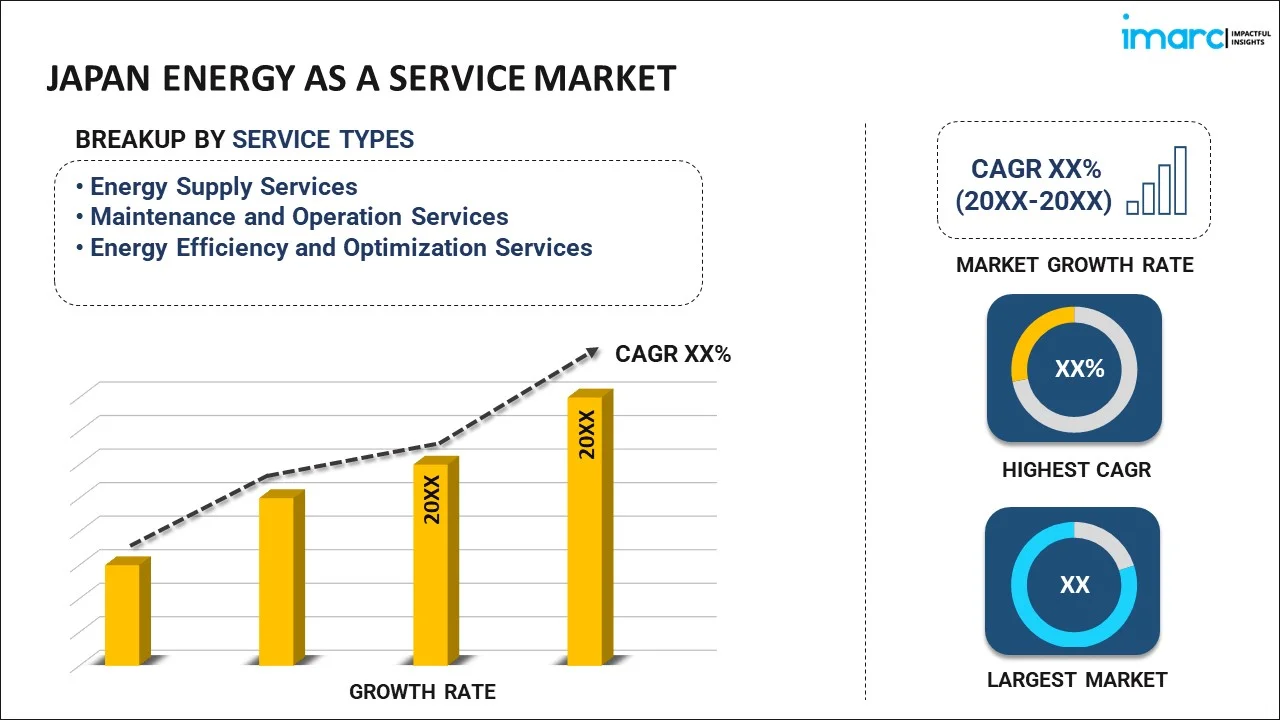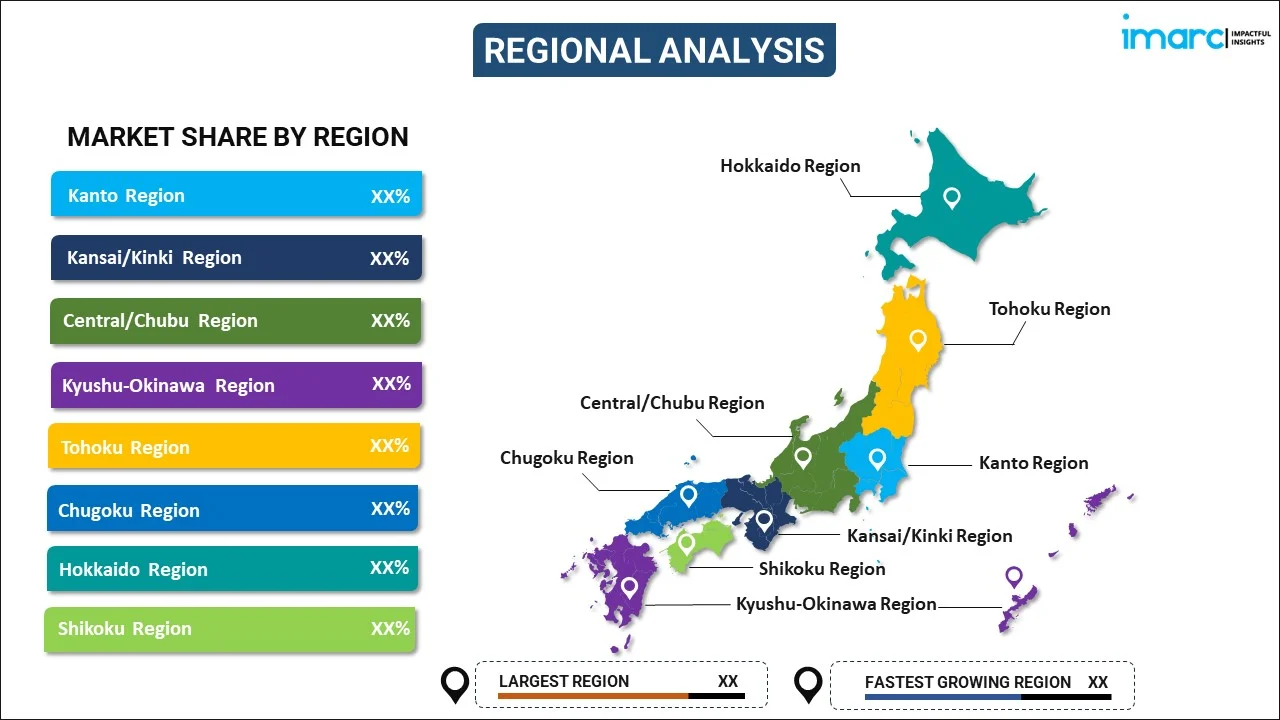
Japan Energy as a Service Market Report by Service Type (Energy Supply Services, Maintenance and Operation Services, Energy Efficiency and Optimization Services), End User (Commercial, Industrial), and Region 2025-2033
Market Overview:
Japan energy as a service market size reached USD 4.6 Billion in 2024. Looking forward, IMARC Group expects the market to reach USD 11.2 Billion by 2033, exhibiting a growth rate (CAGR) of 9.79% during 2025-2033. The growing emphasis on environmental sustainability, which promote businesses to adopt energy solutions that help them comply with standards and reduce their carbon footprint, is driving the market.
|
Report Attribute
|
Key Statistics
|
|---|---|
|
Base Year
|
2024 |
|
Forecast Years
|
2025-2033 |
|
Historical Years
|
2019-2024
|
| Market Size in 2024 | USD 4.6 Billion |
| Market Forecast in 2033 | USD 11.2 Billion |
| Market Growth Rate (2025-2033) | 9.79% |
Energy as a service (EaaS) is a business model that transforms the conventional approach to energy consumption and management. It offers a comprehensive solution where energy providers deliver a range of services rather than simply supplying power. EaaS providers assume responsibility for the entire energy lifecycle, from generation and distribution to consumption optimization. This model allows businesses to outsource their energy needs, fostering efficiency, sustainability, and cost-effectiveness. EaaS often incorporates advanced technologies like smart meters, IoT devices, and data analytics to monitor and control energy usage. By adopting EaaS, organizations can focus on their core activities while benefiting from expert energy management, reducing operational costs, and meeting environmental sustainability goals through optimized energy consumption and renewable energy integration.
Japan Energy as a Service Market Trends:
The energy as a service market in Japan is experiencing robust growth, propelled by several key drivers. Firstly, the increasing regional demand for sustainable and efficient energy solutions has been a primary catalyst. As governments and businesses intensify their focus on achieving carbon neutrality and reducing environmental impact, the EaaS model emerges as a compelling option, offering a holistic approach to energy management. Moreover, the rapid advancements in technology play a pivotal role in driving the EaaS market forward. The integration of smart grid technologies, IoT devices, and data analytics enables more precise monitoring and control of energy consumption, fostering the optimization of energy services. This technological convergence enhances the efficiency of energy delivery and facilitates real-time decision-making, a crucial aspect of the dynamic energy landscape. Furthermore, the flexibility provided by the EaaS model aligns with the evolving needs of businesses. Companies are increasingly drawn towards scalable and customizable energy solutions that adapt to their specific requirements. This flexibility not only addresses operational challenges but also promotes financial resilience by optimizing costs associated with energy consumption. In summary, the confluence of environmental imperatives, technological innovation, and the demand for flexible energy solutions collectively propels the energy as a service market in Japan, heralding a transformative era in the energy sector.
Japan Energy as a Service Market Segmentation:
IMARC Group provides an analysis of the key trends in each segment of the market, along with forecasts at the country level for 2025-2033. Our report has categorized the market based on service type and end user.
Service Type Insights:

- Energy Supply Services
- Maintenance and Operation Services
- Energy Efficiency and Optimization Services
The report has provided a detailed breakup and analysis of the market based on the service type. This includes energy supply services, maintenance and operation services, and energy efficiency and optimization services.
End User Insights:
- Commercial
- Industrial
A detailed breakup and analysis of the market based on the end user have also been provided in the report. This includes commercial and industrial.
Regional Insights:

- Kanto Region
- Kansai/Kinki Region
- Central/ Chubu Region
- Kyushu-Okinawa Region
- Tohoku Region
- Chugoku Region
- Hokkaido Region
- Shikoku Region
The report has also provided a comprehensive analysis of all the major regional markets, which include Kanto Region, Kansai/Kinki Region, Central/ Chubu Region, Kyushu-Okinawa Region, Tohoku Region, Chugoku Region, Hokkaido Region, and Shikoku Region.
Competitive Landscape:
The market research report has also provided a comprehensive analysis of the competitive landscape. Competitive analysis such as market structure, key player positioning, top winning strategies, competitive dashboard, and company evaluation quadrant has been covered in the report. Also, detailed profiles of all major companies have been provided.
Japan Energy as a Service Market Report Coverage:
| Report Features | Details |
|---|---|
| Base Year of the Analysis | 2024 |
| Historical Period | 2019-2024 |
| Forecast Period | 2025-2033 |
| Units | Billion USD |
| Scope of the Report | Exploration of Historical and Forecast Trends, Industry Catalysts and Challenges, Segment-Wise Historical and Predictive Market Assessment:
|
| Service Types Covered | Energy Supply Services, Maintenance and Operation Services, Energy Efficiency and Optimization Services |
| End Users Covered | Commercial, Industrial |
| Regions Covered | Kanto Region, Kansai/Kinki Region, Central/ Chubu Region, Kyushu-Okinawa Region, Tohoku Region, Chugoku Region, Hokkaido Region, Shikoku Region |
| Customization Scope | 10% Free Customization |
| Post-Sale Analyst Support | 10-12 Weeks |
| Delivery Format | PDF and Excel through Email (We can also provide the editable version of the report in PPT/Word format on special request) |
Key Questions Answered in This Report:
- How has the Japan energy as a service market performed so far and how will it perform in the coming years?
- What has been the impact of COVID-19 on the Japan energy as a service market?
- What is the breakup of the Japan energy as a service market on the basis of service type?
- What is the breakup of the Japan energy as a service market on the basis of end user?
- What are the various stages in the value chain of the Japan energy as a service market?
- What are the key driving factors and challenges in the Japan energy as a service?
- What is the structure of the Japan energy as a service market and who are the key players?
- What is the degree of competition in the Japan energy as a service market?
Key Benefits for Stakeholders:
- IMARC’s industry report offers a comprehensive quantitative analysis of various market segments, historical and current market trends, market forecasts, and dynamics of the Japan energy as a service market from 2019-2033.
- The research report provides the latest information on the market drivers, challenges, and opportunities in the Japan energy as a service market.
- Porter's five forces analysis assist stakeholders in assessing the impact of new entrants, competitive rivalry, supplier power, buyer power, and the threat of substitution. It helps stakeholders to analyze the level of competition within the Japan energy as a service industry and its attractiveness.
- Competitive landscape allows stakeholders to understand their competitive environment and provides an insight into the current positions of key players in the market.
Need more help?
- Speak to our experienced analysts for insights on the current market scenarios.
- Include additional segments and countries to customize the report as per your requirement.
- Gain an unparalleled competitive advantage in your domain by understanding how to utilize the report and positively impacting your operations and revenue.
- For further assistance, please connect with our analysts.
 Inquire Before Buying
Inquire Before Buying
 Speak to an Analyst
Speak to an Analyst
 Request Brochure
Request Brochure
 Request Customization
Request Customization




.webp)




.webp)












